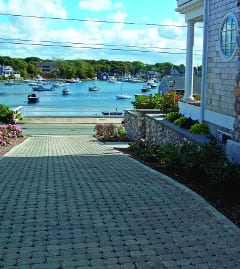by David Smith
This article first appeared in the Fall 2013 issue of Interlock Design, the official publication of Interlocking Concrete Pavement Institute (ICPI), and is reprinted with permission of ICPI Technical Director David R. Smith.
With growing reference by designers, city officials, and informed citizens, the term “green infrastructure” is rising into the national vocabulary. Infrastructure is something we experience daily, every time we walk, bike, drive, or drink a glass of water. We really can’t survive without it. ‘Green infrastructure’ sometimes comes across as more tangible than ‘sustainable’ technologies. And to paraphrase Kermit the Frog, making infrastructure green isn’t easy. Fortunately, creating green infrastructure is worth the effort.

Using permeable pavers (Pavers by Ideal Eco-Stone® Permeable shown here) for driveways helps a project meet multiple green infrastructure goals.
A common deployment of green infrastructure is through the use of vegetation and soil to manage rainfall where it lands, rather than stuffing it in pipes for disposal elsewhere (and to others’ chagrin). Installing green infrastructure has been the basis for resolving years of U.S. EPA litigation with some 770 cities to reduce combined storm and sanitary sewers spilling untreated filth into waterways in violation of the Clean Water Act. Beyond using vegetation, bioswales, and roof gardens, permeable pavement is emerging as a very effective tool for decreasing the volume of stormwater entering combined sewer systems that overload and then bypass the local sanitary waste treatment plant.
Today, many cities are using green infrastructure programs to renovate existing urban infrastructure supporting blocks or entire neighborhoods. The best projects achieve multiple goals. These can be reached with help from permeable interlocking concrete pavement (PICP). A multiplier effect is embedded within the structure of green infrastructure. Here are some multipliers when PICP is used:
Stormwater Management – Many studies have demonstrated that PICP reduces runoff and pollutants by meeting water quality goals through volume reduction, thereby reducing damage to lakes, rivers, and beaches. A key PICP use is reducing combined sewer overflows (CSO) in older urban areas and in turn meeting National Pollutant Discharge Elimination System (NPDES) permit requirements including total maximum daily loads (TMDLs).

PICP can offer a variety of looks while meeting stormwater needs. Pavers by Ideal – Turfstone™ shown here.
Efficient Water Use – PICP recharges aquifers for water supplies and reduces the need for water importation that has plagued regions and states like California. At the site scale, PICP stores water for urban irrigation and vegetation around buildings while supporting shade tree watering and tree longevity.
Transportation and Safety – The texture of PICP can be used to calm traffic in residential neighborhoods, support wayfinding with colored units that mark parking areas while increasing neighborhood identity and urban design contexts. Other permeable pavements cannot do this.
Energy Efficiency – PICP has been used experimentally with horizontal ground-source heat pumps for building cooling/heating in residential and commercial structures. Light-colored paving units can reduce lighting use with reflective surfaces on sidewalks, parking lots and roadways.
Recycling/Reuse – Unlike regular interlocking concrete pavers, permeable pavers can be reinstated after utility repairs. The newly released LEED v4 provides credits for concrete pavers specified with a minimum 10 percent recycled content, e.g., fly ash, silica fume, glass, etc., and materials in the pavement sourced within a 100-mile radius of a project site.
Urban Heat Island – Light-colored concrete paving units can reduce ambient summer temperatures on streets and sidewalks through reflective pavers on roadways. White titanium dioxide coatings can also help reduce the impacts of ozone and photochemical smog.
Education – Signs at PICP projects can educate the public on PICP design and benefits while creating new public expectations from the performance of parking lots, green alleys, and streets. Infrastructure projects must now return multiple benefits to the community.
Economic Development – The scale of some infrastructure projects using PICP are such that homeowners or commercial property owners are motivated to reinvest in their properties. The signal from public sector spending on this is “we want you to stay here, invest and grow families and businesses.” Investment begets investment: This cycle maintains or creates new jobs, a centerpiece of community stability and progress.
No other piece of the infrastructure holds as much potential to contribute to green infrastructure as PICP. Fortunately, cities are recognizing this contribution at an unprecedented pace, and Interlocking Concrete Pavement Institute (ICPI) continues to respond with the technical resources needed to make each project’s design, construction and maintenance successful. Visit www.icpi.org/permeable. You’ll be surprised at what’s there.
About the Author
David R. Smith is the Technical Director of Interlocking Concrete Pavement Institute (ICPI). As the leading technical organization on segmental concrete pavement systems, the Interlocking Concrete Pavement Institute (ICPI) provides substantial resources to concrete paver producers, contractors, suppliers, design professionals, and consultants. Members representing this growing industry support the association’s mission to increase the awareness, acceptance, and use of segmental concrete pavement systems while utilizing its wealth of resources to gain a competitive business edge.


